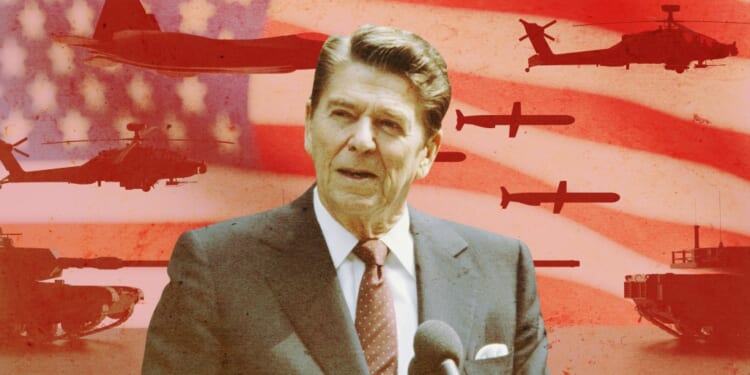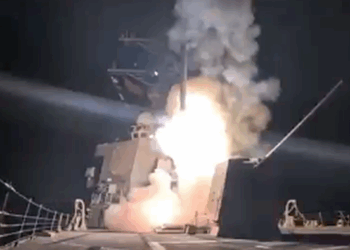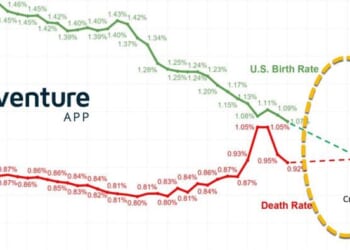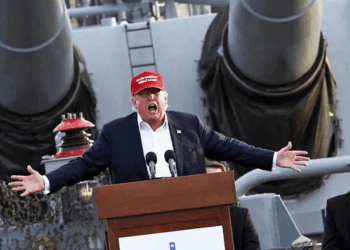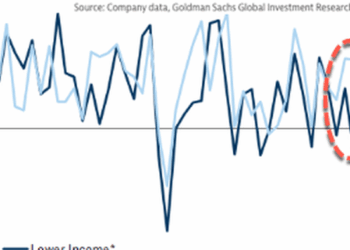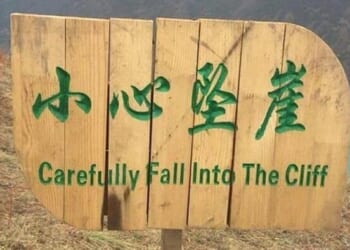
Editor’s Note: The United States and China are firmly locked in a cold war struggle whose outcome will be the most important determinant of peace, prosperity, and quality of life in international politics over the next decade. This article is the second in a series that will propose a strategy for the United States to conduct and win this conflict, based on lessons from the Cold War with the Soviet Union. Read the first entry here.
The architects of America’s Cold War victory over the Soviet Union mastered two essential perspectives on competition as the foundation of their strategy and statecraft. What’s remarkable—and speaks to their intuition—is that both perspectives weren’t actually formulated and written down until several years later, in the 1990s. And those arguments were written for entirely different reasons, by people who weren’t thinking about Cold War statecraft or about the Soviet Union—but rather the nature of competition.
The first was a 1994 Foreign Affairs article, “Competitiveness: A Dangerous Obsession” in which Paul Krugman sought to quell anxieties about U.S. competition with Japan by noting the strength of a country’s economy and its living standards depend almost entirely on its own productivity and not on whether it somehow “wins” against other countries in trade (ironic to hear in the present moment!). Krugman was countering what he saw as a natural but faulty intuition: the idea that countries compete with each other the same way for-profit companies compete in a market economy.
That’s just a bad and misleading analogy, Krugman argued. There’s no national profit and loss statement, customers don’t get to choose countries the way they choose companies, and so-called national competitors buy and sell from each other on a regular basis. Krugman’s real point was that such intuition led to useless obsessions with trade deficits, which in turn drove dysfunctional policies like protectionism and inefficient subsidies, both of which sap domestic productivity and lead to lower living standards. Why bother? According to Krugman, countries rarely merge or undergo “acquisitions” and when they do it’s about war, not trade. And countries don’t go bankrupt or go out of business the way companies do.
Except he was wrong about that last point when it came to the Soviet Union—which did essentially go out of business. That happened in large part because of a decline in productivity, rooted in a dysfunctional economic philosophy and practice—but accelerated by American statecraft. A certain type of competitiveness wasn’t a dangerous obsession for 1980s America. It was a necessary obsession and tool of Cold War statecraft.
The second perspective on competition was Clayton Christensen’s 1997 book, The Innovator’s Dilemma, which introduced the concept of “disruptive innovation” into the lexicon. That phrase (and its shorter version, “disruption”) has today come to mean almost everything to everyone, but in Christensen’s mind it had a very specific derivation, meaning, and set of consequences. What Christensen sought to explain was a strange and repeated paradox: A series of well-managed companies, doing what was supposed to be the “right” thing by listening to their best customers and focusing on their most profitable markets, were losing out to upstarts. Why? They made the mistake of thinking that their competitors would need to be able to do everything they could do for customers from the very start, and do it all better, to take over market leadership.
A country that views itself as the pinnacle of political and economic organization—history’s most vibrant democracy coupled with the most robust economy—will have a difficult time understanding why seemingly imperfect competitors can actually pose a serious threat to American global leadership.
Not true. Disruptive innovators in their early days typically underperform on
“normal” metrics. Their products seem like poor substitutes for market leaders—cheaper but less useful than the best products. But disruptive innovators have found a steeper trajectory of improvement. With time, they can become serious competitors, gain customers, and become the new market leader. The problem is that the old market leader usually can’t see what’s coming, because the less capable competitor is easy to dismiss.
It might seem a stretch to apply this to global competition between great powers. It isn’t, particularly for the United States. A country that views itself as the pinnacle of political and economic organization—history’s most vibrant democracy coupled with the most robust economy—will have a difficult time understanding why seemingly imperfect competitors can actually pose a serious threat to American global leadership. Indeed, there were moments during the second half of the 20th century, particularly during the late Cold War, when the American foreign policy elite took this view with regard to the Soviet Union, assuming that no third country would choose to ally with Moscow if it had a choice. Why would it do so, seeing as how America’s political and economic “product offering” was by definition superior on every important dimension?
And there is still a strong contingent of American policy intellectuals who believe the same about China. In that view, the interconnected Chinese political and economic systems are destined to underperform—less free, less innovative, less capable of producing welfare, social cohesion, and opportunities for the pursuit of meaningful lives and happiness.
But the logic of disruptive innovation clouds that picture, because it explains why the Chinese system does not need to be better than America’s on all or even any one of these dimensions to successfully compete (and possibly win). The system only has to appeal to what Christensen would have called “new market segments” (such as emerging economies and societies) and—most importantly—be seen as capable of faster and steeper improvement.
Cold War statecraft of the 1980s understood this dynamic with regard to the Soviet system. The Soviet Union could at once be a less capable and less attractive great power, and at the same time could win the Cold War, in the same way that disruptive innovators win.
The genius of 1980s Cold War statecraft was to incorporate both these insights, ported to geopolitics, into a coherent synthesis. The U.S. and the Soviet Union were indeed locked in a competition that was not destined to go on forever. One country could indeed win and one could lose, in spectacular fashion, and not necessarily through direct kinetic conflict, since that was made almost impossible (at least through intention) by nuclear deterrence. And there was no guarantee that the “better” county would necessarily win, because competition doesn’t actually work that way. Disruption by a less capable competitor was absolutely within the realm of possibility.
That brought a sense of urgency to the 1980s Cold War, urgency that had seeped away a bit in the 1970s as détente first rose and then quickly fell. As I described in the previous piece in this series, late-1970s America was a pretty despondent place in geopolitical terms, with a loss of momentum in domestic economics, foreign policy, and overall zeitgeist.
The most natural thing in the world at that moment would have been for Washington to seek a return to the détente-style superpower equilibrium of 1972—a nuclear arms control regime, rules of the road for ongoing struggles in the developing world, a reaffirmation of de facto spheres of influence in Europe—in all, a balance of power concept that would (as it had from the mid-1960s) prevent dangerous crises in places like Cuba and Berlin, and allow both the U.S. and the Soviet Union to manage the challenges in their respective economies and societies without overt or even very much covert interference from the other.
A return to the status quo “balance” of the early 1970s would have looked like a pretty good thing in 1979. And while it’s impossible to run the historical counterfactual, it seems likely that if Jimmy Carter had won the 1980 election, this would have been his second administration’s likely objective. Whether it would have succeeded or not isn’t the point (though the theory of disruptive innovation suggests that it would have been precarious at best).
The point is that the Reagan administration fully rejected the idea of seeking equilibrium as a goal. Instead, it set out to win—unambiguously and without reservation. And with a theory of statecraft that intuitively understood what Krugman missed, and what Clay Christensen did not—the Cold War really was a competition with winners and losers, and to be the winner, you might have to play a different game than the one that had previously gotten you to the top. And a different game than the adversary was playing.
What did that mean in practical terms? Three big things, all of which are going to be relevant and meaningful for how the U.S. can in this coming decade win the cold war with China.
First and most important was the underlying proposition that containment was not enough and that what Reagan called “rollback” would be the new goal of American statecraft. This meant denying George Kennan’s historic 1947 containment precepts—that if the U.S. could maintain its inherent strengths and draw a firm line in the sand against Soviet expansion, the passage of time would inevitably lead to the weakening of Soviet power. The Cold War would then essentially run out of steam. The U.S.’s 1980s statecraft overtly rejected the containment argument as passive, self-defeating, and vulnerable to disruptive innovation. The objective instead was to actively exploit the weaknesses of the adversary and present to the other side tougher dilemmas, faster. Balance of power thinking was replaced by an American version of what the Russians termed “correlation of forces,” which really meant aiming for an imbalance of power in favor of one side over time. This meant dropping the political and intellectual attachments to stability and status quo in favor of an ambition to win.
The second ingredient was about controlling the risks inherent in a rollback approach, by seeking a predominance of military power that would move the U.S. toward “escalation dominance” in as many realms as possible. Escalation dominance means the ability to win a battle of any intensity at any place where the adversary might seek to engage. It’s almost impossible to achieve in practice—full escalation dominance would mean an adversary would have no better option than to surrender in advance—but the closer you get to escalation dominance, the less freedom of action for anyone seeking to challenge your position.
Nuclear deterrence based on mutually assured destruction (MAD)—the grounding principle of 1970s détente and status quo thinking—puts a hard constraint on the concept of escalation dominance. Of course, that same constraint operates on both sides, so it was possible for deterrence theorists to imagine a state of escalation dominance at every other level below strategic nuclear conflict, which might be just as effective if the choice to go that additional step was shut down equally for both sides by MAD. But that’s theory, not practical statecraft. In practice, the risk of a mistake or (more likely) a desperate bet by a losing side on raising the risks of apocalypse was simply too high to accept. Instead, 1980s Cold War statecraft turned to two alternate means of getting closer to escalation dominance: a technology offset and sophisticated intelligence.
Soft power is vague and ambiguous when it is thought of as a quality of being liked or admired from abroad. It is neither vague nor ambiguous, but actually quite powerful when it means a leadership vision that shows a positive directionality for social and economic change.
The tech offset idea—centered at Andrew Marshall’s Office of Net Assessment in the Pentagon—was the U.S.’s version of what today we call asymmetric warfare. The Soviet Union had built and fielded in the European theater a conventional army with more soldiers, tanks, and armored personnel carriers than the U.S. could reasonably expect to match. It wasn’t just that Americans didn’t want to pay the costs: Most of the world’s contested Cold War theaters were physically much closer to Moscow than to Washington, without an ocean in between. So rather than try to match the Russians one for one, the tech offset approach relied on advanced technology to counter brute numeric advantage. Advanced aircraft would win against more aircraft; sophisticated sensors and control systems would make one American tank more effective than three Soviet tanks.
The most audacious move was, of course, the 1983 Strategic Defense Initiative (SDI), better known as Star Wars. In a dramatic rebuke of détente, status quo, and “stability” thinking, Reagan called for an epic tech offset that would undermine MAD by pressing the American advantage on missile defense technologies (even though those technologies were and in many respects remain far behind what would be needed to intercept intercontinental ballistic missiles).
Nuclear deterrence theorists were horrified. Russian academics visiting the Center for International Security and Arms Control at Stanford (where I was a Ph.D. student at the time) alternated between bemusement at the quixotic nature of it all and downright joy at the idea that the U.S. was now going to waste vast resources from the defense budget on something that would never work. However, the actual decision-makers in Moscow could not afford to take that view. They had to grapple with the “what-if” question: What if the U.S. were to achieve a breakthrough and undermine the Russian deterrent? They had little choice but to now run a different race, on a track and at a pace that the U.S. had suddenly shifted to its advantage.
Adding to the tech offset ambition was a parallel offset in strategic intelligence. Cold War statecraft relied heavily on investments in deeper and better intelligence to more accurately identify strengths and vulnerabilities in the Soviet system, and not just the Soviet military. We now know that the U.S. intelligence community was in the 1980s closely tracking evidence for an “alternative hypothesis” that the USSR was not ascending but was in fact faltering as its economic base corroded and its social pact started to unravel. The intelligence community welcomed heterodox voices, collaborated closely with external partners (like Royal Dutch Shell, where the Global Business Environment Unit in the late 1970s was keeping tabs on a party functionary named Mikhail Gorbachev), and brought a disciplined approach to evaluation through its Analysis of Competing Hypotheses method, developed by CIA analyst Richard Heuer in the 1970s.
The third big ingredient was a strong, optimistic, globally oriented leadership proposition based on ideas as much as power. It was easy at the time to mock Reagan’s “morning again in America” messages as campaign rhetoric and exaggeration. But it is a profound observation that forward-looking optimism beats pessimism and even more so cynicism, not only as a matter of public affairs and communications but as an ingredient of soft power. In modern geopolitics, leaders need followers as much or more than the opposite. Alliances are more than promises of military aid and vague narratives about multilateralism for the sake of multilateralism.
Cold War statecraft eschewed many of the more ceremonial aspects of alliance in favor of harsh bargaining where it was needed to prosecute the new Cold War strategy—and particularly in the U.S. relationship with West Germany when it came to energy supplies, intermediate-range nuclear forces, and emotionally charged Ostpolitik, Germany’s version of détente with the East. On multiple fronts the U.S. pressed its (mostly reluctant) European allies to join the new competition. In return, it offered a model of robust economic growth through a trade and investment network of shared prosperity. It offered a vision of a future where one could imagine that the Russians might just “tear down this wall” in Berlin.
Soft power is vague and ambiguous when it is thought of as a quality of being liked or admired from abroad. It is neither vague nor ambiguous, but actually quite powerful when it means a leadership vision that shows a positive directionality for social and economic change. Moral clarity can be divisive in big and complex societies with massively diverse populations, but it can also be inspiring. Labeling the Soviet Union in 1983 as “the focus of evil in the modern world” horrified the status-quo and stability seekers among foreign policy elites around the world as much or more than did Star Wars—but from the perspective of soft power accumulation, it was a masterstroke.
As is generally true with ideologies, there’s no leadership proposition you can plausibly offer to others unless you can effectively manage the conflicting beliefs in your own coalition. Cold War statecraft did just enough of that, in part by combining a package of neoliberal economic principles with commitments to the promotion of democratic governance and human rights abroad. That might sound overly ambitious or even quaint in today’s world, but it was a workable package for 1980s conservatives and the new right of the time. The balance was to temper those more extreme elements by imposing pragmatic statecraft on top of preferences for forceful democracy promotion on the one hand, and libertarian and religious conservatism on the other.
No formula for success can be directly transposed from one historical era to another. And no formula accounts for every specific detail and decision that practical statecraft involves. I’ve described here the 1980s Cold War formula as made up of three fundamental ingredients: rollback over containment, risk management through tech offsets and strategic intelligence, and an ideas-based leadership proposition. These ingredients together guided the strategy to a winning place in just under a decade.
The grounding proposition here is that these same three ingredients can guide the development of a strategy and specific tactics for winning this decade’s cold war with China. The test of that proposition will come in spelling out those policies and tactics to deal with contemporary issues on the Sino-American agenda—such as territory, trade and finance, energy and environment, and technology. The next article in this series will take on what may be the most controversial and consequential of these for 2026—the intensifying competition in artificial intelligence.

